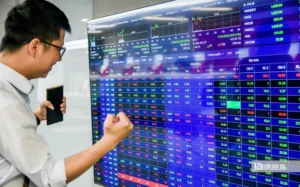One-third of 2025 has passed, according to economic experts, to achieve the growth target, our country needs to accelerate the disbursement of public investment capital and stimulate consumer demand.
The economic picture is improving but there are still hidden “worries”
Statistics from the Ministry of Finance show that in the first quarter of 2025, the economy recovered positively with GDP growth reaching 6.93% over the same period. Thus, GDP growth in the first quarter decreased significantly compared to 7.55% in the fourth quarter of 2024. Notably, this figure is lower than the growth target of the full-year GDP scenario of 8%. This has created great pressure on the following quarters, especially in the context of global fluctuations and trade tensions due to the US tariff policy.At the regular Government meeting in March 2025, Prime Minister Pham Minh Chinh assessed that GDP growth in the first quarter of 2025 reached 6.93%, higher than the same period of the past 5 years and higher than the initial growth scenario, although still lower than the new growth scenario. The fact that Vietnam’s growth is among the highest in the region and internationally is a positive sign in the current context.
Statistics also show that although the agriculture, forestry and fishery sector had a higher growth rate (3.74% compared to 2.99%), the growth rate of the industrial – construction and service sectors slowed down (growth of the industrial – construction sector decreased from 8.35% to 7.42%, and the service sector decreased from 8.21% to 7.7%).
Explaining the cause of this situation, Dr. Nguyen Duc Do – Deputy Director of the Institute of Economics and Finance (Academy of Finance) said that it was due to the slowdown in exports. In the first quarter of 2025, exports increased by only 9.71% over the same period, lower than the 11.35% of the fourth quarter of 2024. Asset accumulation also slowed down from 7.98% to 7.24%. In particular, final consumption maintained a growth rate of 7.45%, a slight decrease compared to the 7.54% of the fourth quarter of 2024. This figure is also equivalent to the growth rate compared to the same period of total retail sales of goods and consumer service revenue in the first quarter of 2025 after deducting the price factor of 7.5%.Currently, the amount of unallocated capital is still quite large (57.7 trillion VND, accounting for about 7.0%) of 19 ministries, central agencies and 32 localities.
Furthermore, according to statistics from the Ministry of Finance, the estimated disbursement of public investment capital from the beginning of the year to March 31 was VND78,712 billion, reaching 8.98% of the plan, reaching 9.53% of the plan assigned by the Prime Minister. In the first 3 months of the year, many ministries, central agencies and localities have not disbursed. Specifically, 17 ministries and central agencies have not disbursed, 16 ministries, central agencies and 6 localities have disbursed less than 5%…
Accelerating disbursement of public investment capital and stimulating demand
Commenting on the coming time, Mr. Do said that in the second quarter, exports may still achieve a fairly good growth rate. However, in the second half of 2025, exports will grow more slowly due to the US’s reciprocal tax policy being higher than the current level, as well as the risk of a trade war between the US and major partners that could cause the world economy to slow down, even fall into recession. Not to mention, the control of goods origin also affects the export scale. “In the context of the uncertain world market, at least in the short term, our country’s investment, production and business activities will be affected,” Mr. Do emphasized.
For an economy that has been heavily dependent on exports like ours, achieving the 2025 growth target in the current context is facing many challenges. “Growth drivers are severely affected, macroeconomic stability faces increasing risks, and social security work may face many challenges,” said Minister of Finance Nguyen Van Thang.
Therefore, according to economic experts, to achieve the GDP growth target of 8% in 2025, accelerating the disbursement of public investment capital and stimulating consumption demand is the “key” to success. Consumption and public investment are expected to be the main drivers of economic growth in the coming time, instead of exports and private investment. “The Government needs to be decisive, accelerate the disbursement of public investment capital and issue effective policies to stimulate domestic consumption. In which, it is possible to use solutions such as lowering interest rates, reducing taxes…”, Mr. Do affirmed.
Regarding this issue, according to Mr. Shantanu Chakraborty – Country Director of the Asian Development Bank in Vietnam, ensuring effective and timely public investment flows in the next 9 months will be a key factor for Vietnam to achieve its sustainable growth goals in 2025.
Faced with urgent requirements, Prime Minister Pham Minh Chinh has just requested ministries, central agencies and localities to accelerate the disbursement of public investment capital in 2025. In addition to severely criticizing 19 ministries, central agencies and 28 localities for not fully allocating the public investment capital plan from the state budget in 2025 that has been assigned, the Prime Minister requested ministries, central agencies and localities to thoroughly grasp and clearly identify the task of accelerating the disbursement of the public investment capital plan in 2025 as one of the top key political tasks that need to be prioritized.
At the same time, stimulating domestic consumption is also an important “key”. According to Dr. Nguyen Bich Lam, former Director General of the General Statistics Office (now the General Statistics Office), stimulating consumption is an important factor that drives economic growth. Our country needs solutions to stimulate this consumption motivation.
“In particular, it is necessary to apply support policies to promote consumption such as policies to support workers. Vietnamese people have to spend on domestically produced goods and services, so it is necessary to promote the Campaign “Vietnamese people prioritize using Vietnamese goods”. If people consume imported goods and use imported services, it will invisibly reduce domestic GDP…”, Mr. Lam further analyzed.
















